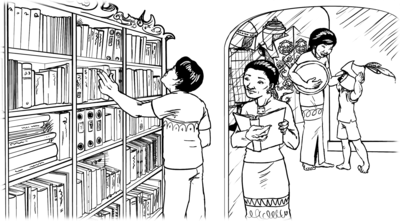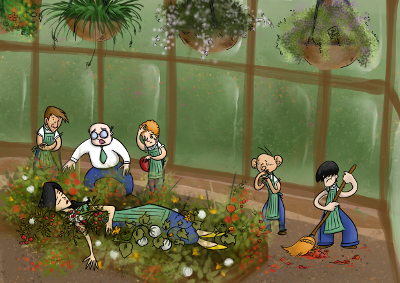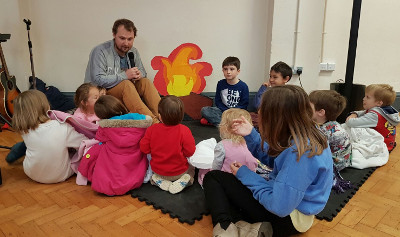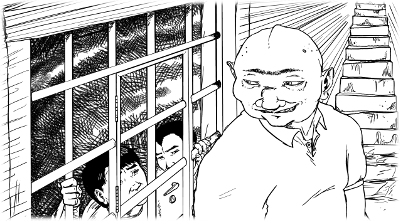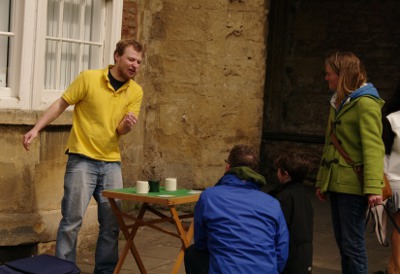First Past the Post - Rules
Aim
Your aim is to win an election under the 'First Past the Post' (FPTP) system using tactical campaigning and creative border adjustments (Gerrymandering).
To do this you must win the most Constituencies, by having the most votes in each one.
Tip: Don't waste your campaign budget by winning Constituencies by more than you need to. One vote more than your opponent is enough.
Equipment
- Map: The board on which you will play. Representing the country you intend to rule.
- 50 Budget Cards: Cards with the numbers 1 -- 50. These represent your budget for Campaigning.
- 32 News Cards: These represent events that you, as a political party, have to respond to during your campaign.
- 8 Gerrymander Hexes: Hexagon cards, 2 in each Constituency colour. These can be used to adjust Constituency boundaries.
- Vote Counters: Coloured counters to represent the winning vote of each Hex. These are stackable to enable a variation called AV (Alternative Vote)
- Battle Bus: A counter to show which Hex is currently being Campaigned for.
Key Terms
- Hex: An area which, for simplicity, is considered to vote as a block. These are represented by a hexagon on the map.
- Constuency: A connected group of Hexes that are all the same colour.
- City: A Hex that acts as the center around which the Constituency is built. They are represented by a city image in the Hex.
- Town: A Hex with a town symbol in, either Large or Small. Used for resolving ties over a Constituency.
- Rural Hex: Any Hex that is not a City or Town.
- **Campaign:**To try to win a Hex, using Budget Cards and News Cards to earn Sway.
- Sway: Popularity in a Hex. The player with the most Sway wins the Hex.
- To Gerrymander: To change the Constituency a Hex belongs to by placing a Gerrymander Hex over that Hex.
- Discard: Place a card face up in a pile next to the main draw pile of it's type.
- Pay: Discard a Budget Card of at least the required Cost.
- Active Player: The player who's turn it is.
Setup
Shuffle the News Cards and place them in a pile, face down, beside the Board.
Shuffle the Budget Cards, and deal to each player equal to the number of players plus two. Place the rest in a pile, face down, beside the Board.
Place all of the Gerrymander Hexes, face up, beside the Board.
Each player also chooses a colour and takes the Vote Counters of their colour.
Playing the Game
Tip: To play with children, or for a quicker game, ignore the News Cards and any instrutions relating to them.
Each player takes it in turns clockwise around the table to:
- Draw Budget Cards
- Draw and Play a News Card
- Campaign for a Hex
Draw Budget Cards
You must draw Budget Cards until you have cards equal to the number of players plus two.
eg: If there are 4 players, draw cards until you have 6 in your hand.
If there are no cards left to draw. Shuffle the discard pile, and place it as the new draw pile.
Draw and Play a News Card
Draw a News Card from the top of the pile, and do as it says. If the News Pile is empty, skip this step. Do not draw from the discard pile.
There are two main types of News Cards: Permanent and Action. The type is written at the top right corner of the card.
- Permanent Cards: If you draw a Permanent Card, you must choose a player, including yourself, to take it. This player must then place it in front of them so that everyone can see it.
Permanent cards have status affects on the player holding them, such as increased/decreased Sway in certain locations. These effects are combined where applicable.
Each player can only hold 2 of these cards at a time. If you need to place a third, you must choose one of the others to Discard first. - Action Cards: If you draw an Action Card, do as it says and Discard it.
If the card says "You may" then you are not forced to perform it's action. If you choose not to, then do not discard it. Instead, put it on the bottom of the draw pile.
Emphasis: No News Card should ever be used twice. If you do not use a card, put it on the bottom of the Draw Pile. If you do, then Discard it.
When the News Cards run out, do not replace the empty Draw Pile with its Discard Pile.Campaign
Each Campaign focuses on a single Hex. The active player chooses the Hex they wish to Campaign for by placing the Battle Bus on it. You may not place the Battle Bus on a Hex that already has a Vote Counter on it.
Each player must choose a Budget Card from their hand, and place it face down on the table. That is, unless they have no Budget Cards in hand, in which case they cannot campaign this round.
Once every player has done this, the cards are revealed. Each player then calculates their total Sway. The player with the most Sway wins the Hex, and places a Vote Counter of their colour on that Hex.
Sway is calculated by adding the value on the Budget Card to any bonus Sway from any News Cards, (and Scenario Cards), you are holding that affect this Hex.
In the event of a tie: * If the active player is involved, the active player wins. * Otherwise, tied players draw a Budget Card. The highest wins the Hex.
All used Budget Cards are then Discarded.
Gerrymander
Some News Cards have the option to Gerrymander. You do this by taking a Gerrymander Hex of the appropriate colour, and placing it on the board to increase the size of a constituency.
- You must place it on a Rural Hex next to a Hex of the same colour.
- You may place it on a Hex with or without a Vote Counter.
- You may not Gerrymander across national borders.
- You may not place it in a Hex of the same colour.
- You may not place it so that it cuts a Hex off from it's City.
- You may not place it so that it joins two Constituencies of the same colour.
- You may not place it on a Hex that has already been Gerrymandered.
Once a Hex has been Gerrymandered it belongs completely to it's new constituency.
Ending the Game
The game ends when every Hex has been won, or when every player agrees it is not possible for any Constituency to change hands.
At this point, calculate which player wins each Constituency.
The player with the most Vote Counters in a Constituency wins that Constituency.
In the event of a tie within a Constituency:
- If one of the tied players has the city, they win the Constituency.
- Otherwise, if one of the tied players has a Large Town, they win the Constituency.
- Otherwise, if one of the tied players has a Small Town, they win the Constituency.
- Otherwise, each tied player draws a Budget Card, and the highest wins the Constituency.
The player with the most Constituencies wins the game.
Early Leavers
At any point, players may withdraw from the game and Discard all of their cards. As soon as they have done this, they are out and may not make any more plays, nor may they return to the game.
All Vote Counters remain on the board, and at the end of the game their score is still counted, so the player may still win.
Other players will now draw one less card on their turn. That is the new number of players plus two.
As soon as there is only one player remaining, all empty Hexes are claimed by the remaining player. Score is still counted, and it is still possible for another player to win the game.
Variations
Alternative Vote (AV)
Alternative Vote is another possible voting system. Under this system a player must have an Absolute Majority to win each Constituency. That is more than half of the votes.
A player has an Absolute Majority if they:
- Have more than half of the Hexes.
- Have exactly half of the Hexes, but one of them is a City Hex.
When Campaigning, all players add a Vote Counter to the Hex in a stack. The player with the most Sway at the top, and the least at the bottom.
When calculating the winner of the Constituency, look only at the top of the stacks.
- If a player has an Absolute Majority, they win the Constituency.
- Otherwise, remove the Vote Counters of the player with the least Votes in the Constituency from the Constituency, then count again.
- Repeat until one player has an Absolute Majority.
In image A, Blue has the most votes, and so under FPTP blue would win. Blue does not however have an Absolute Majority, even with the City. There are 9 Hexes so Blue would need 5 Votes.
Yellow has the least Votes, so we remove Yellow altogether. Image B shows the result of doing this.
Now Red has 5 Votes and wins the Constituency because more than half of the voters preferred Red to Blue.
nb: Under FPTP, Yellow voters may have voted for Red because they really didn't want Blue to win. Their votes would not have been true to what they really wanted.
If you are not sure who's Vote Counters to remove, because more than one player has equally the fewest Votes:
- If either player has a City Hex, or Town Hex, the player with the largest of these, has the most Votes. Remove the other player's Vote Counters.
- If both players only have Rural Hexes, the player, who's Vote Counter is highest on the City stack has the most Votes, remove the other.

